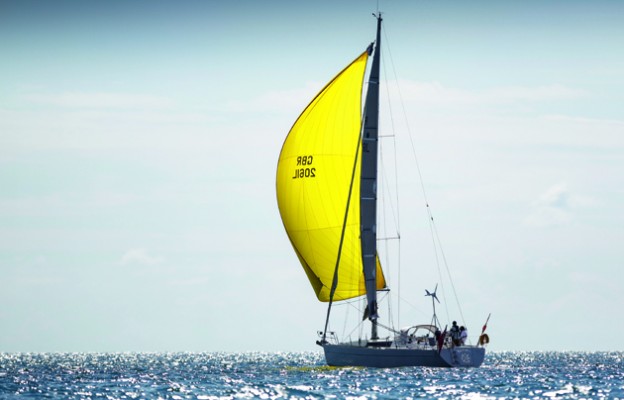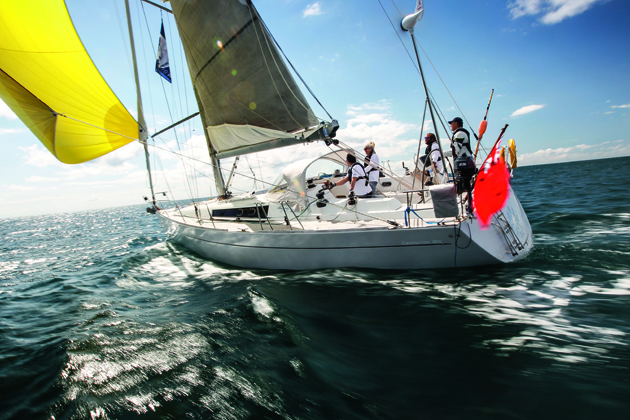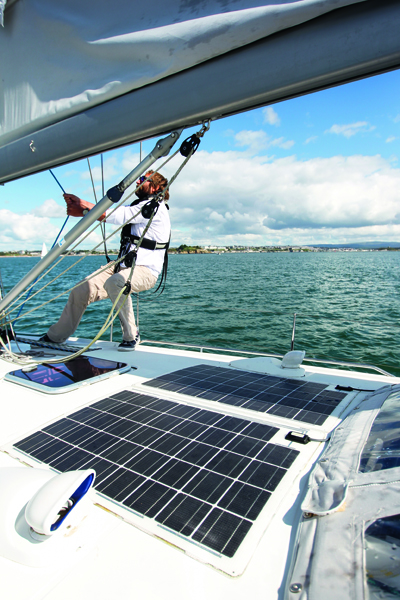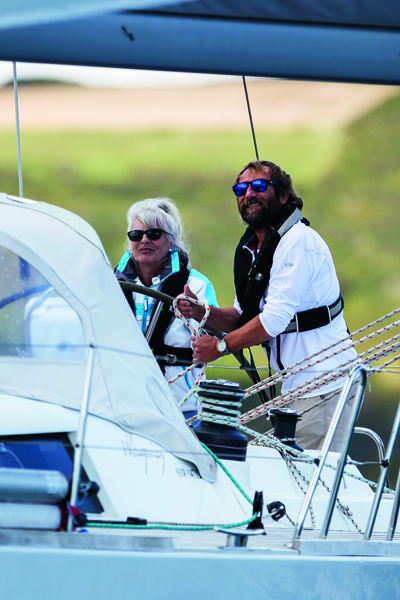Meteorologist, navigator and ARC safety inspector Chris Tibbs and his wife, Helen, are going round the world, starting with the ARC. He describes how he prepared his yacht
When we bought our Wauquiez Centurion 40s, Taistealai, for ocean cruising, starting with the ARC this year, we had a number of criteria in mind, but first and foremost we wanted a boat that would be manageable by two. Nothing too big or heavy, yet substantial enough to cross oceans reasonably quickly and be fun to sail.
Most importantly, our budget had to leave enough over to prepare her properly. After a couple of demo sails we ruled out roller reefing mainsails. Maybe it’s my racing background or the design of yacht we tried, but we found the performance disappointing and the reduced size of mainsail seemed small for the boat.
There were compromises we were prepared to make, but we did try to adhere to the principles of keeping it simple, manageable and repairable in the middle of nowhere or be prepared to do without.
I had been advised that it’s best to leave a considerable part of the budget for a refit; this is probably a bigger chunk than you might initially think, so these were wise words. Make your estimate and double it would be my advice!
Also increase the time you think it will take to do the refit as jobs are often more difficult than expected largely owing to the restricted space.
Checking the bottom
Your yacht has to take you safely for many thousands of miles through mixed weather conditions and one of the most important aspects is keeping the water on the outside. Steering gear and stern glands can cause difficulties and need to be checked.
Aboard Taistealai instead of a stern gland we have a saildrive unit and our manual tells us that every seven years the rubber seal needs to be replaced. You may be told that these rubber seals last a lot longer than this, and there will be boats sailing around with seals two and three times the recommended age, but I didn’t want to take any chances – I thought we would look very silly sitting around in a liferaft because we had not changed it.
However, this was a much bigger job than I had anticipated, involving the engine having to be split from the drive and moved forward. Although I will tackle most things on a yacht, this was a time to call in the experts.
It made sense to do it during the winter refit we planned while the boat was on the hard as it avoided an additional lift. The cost was fierce, but we feel much happier now it is done.
The next job was checking the rudder bearings and keel. Both got a clean bill of health from the surveyor, but after the report into the loss of the yacht Cheeki Rafiki last year we had another good look. Our seacocks were also checked and the seawater inlet one replaced on the leg of the saildrive.
Some yachts look like a colander under water, they have so many seacocks. One thing I like about Taistealai is that we only have a few. Although a saltwater pump in the galley is a great water-saving device, we considered a new hole in the hull for it too high a price to pay, particularly as we had fitted a watermaker and carry plenty of buckets.
In addition to the main seal on the saildrive, there is an outer rubber that is stuck to the hull, or should be. After the engineers replaced the main seal they stuck it up with contact adhesive, only for it to drop off almost immediately. The next time the boat was out the water I used a marine sealer/adhesive and filled and faired around the edges.
So far it is OK and I will keep my fingers crossed for next time we check – hopefully in the warmer waters of the Canary Islands.
While changing the anodes, I got plenty of spares for the next couple of years as the size and type may not be readily available in the Caribbean. We also noted the type of antifouling and checked that the Canary Islands, where the boat will next be lifted and scrubbed before the ARC, do keep the same make and type of antifouling.
Of course, we are not racing, but when long-distance cruising marine growth and a badly prepared bottom can easily cost a quarter to half a knot or more – say ten miles a day, which would mean an extra day or more for a transatlantic crossing. And although I love being at sea, I also like sailing quickly and I think we all like to try to beat similar boats on passage.
Changing the rigging
The next major items to be tackled were the rigging and sails. Ask different riggers or insurance companies how often you need to change your standing rigging and you will get answers varying from around seven years for rod and ten for 1×19 wire.
Our insurers were not insisting, but they did strongly suggest we changed our nine-year-old rigging as a precaution as it would be a lot cheaper to replace it in the UK than it would if we were to lose our mast in the Pacific.
They had a point, although the biggest saving would surely have been to them. However, it was something we had discussed and budgeted for. We wanted a known rigger (to us) to do this work so we went to Jerry the Rigger in Gosport. I have known him for a long time and he knows a lot about long-distance cruising yachts, having worked with the ARC for a number of years.
Changing the rigging also forced us to do something that racing crews do often and cruising crews rarely, that is, to pull the rig – take the mast out and give it a good inspection. When buying a second-hand boat there is usually a caveat on the survey that tells you that the surveyor has done little more than look at the mast through binoculars. We had no idea how the mast had been used and abused or when it was last properly lifted and checked.
So although it was a large expenditure we now have a well-checked mast with new rigging wire and, importantly, I now have a much better idea about how it is all put together and where any problems might develop in the future.
We picked up a few points, one of which was the rings through which the spinnaker halyards are led: these were incredibly small so were replaced by stand-up blocks.
On the gooseneck there were insufficient washers to pack it out, causing wear. It was the exactly same case with the vang fitting.
Then we had a new set of steering cables made up, a strop for padlocking the dinghy when going ashore and a repair kit should a wire or stud fail; all small but necessary items.
Sail choice
While measuring the steering cables we completely checked and serviced the system. So with a serviced hull, stern gear, engine and mast, the basics are fine. The boat is ready for sea, but not in any way luxurious.
I am often surprised at how often I see engines and generators being serviced in Las Palmas before the start of the ARC, but how little activity I see checking the rig, sails, or servicing winches – maybe they have all been recently done, but I doubt it.
Sail choice is a huge subject. We bought a boat with a good sail inventory, but we still added to it as sails are our driving force. I have quite strong opinions on sail plan. Ours includes a 110 per cent high-clew headsail to allow good visibility forward and it sets nicely poled-out. We also have a removable inner forestay for a heavy weather jib and storm jib, along with three reefs in the main.
I do not like trysails as when it is windy enough to need one on a cruising yacht I do not want my crew having to work on the coachroof to set it. Unless you have a second mast track, trying to set a trysail in a track in 40-plus knots is difficult and dangerous. A good third reef will reduce the sail to a manageable size in a reasonably easy manner.
When I was a skipper in the BT Global Challenge round the world race, the only time we used the trysail was when doing running repairs to the main, not when beating in 80 knots in the Southern Ocean – although at 80 knots we did heave-to for a while.
Although our standard sail plan aboard Taistealai is small with the 110 per cent jib, we do carry sails for light winds as well, but more of this in a later article.
The comfort factor
Once happy with the basics we looked at what will make us more comfortable and safe. Fundamental to a pleasant crossing, I believe, is sufficient power. On my first transatlantic in 1980 we were short of battery capacity and even resorted to removing the light bulb from the heads. We had oil cabin lights, which does give an easy light that doesn’t destroy night vision, and instruments were limited.
Some 35 years later, the choices are different. I changed all our bulbs to LED and added alternative methods of generating power. Power generation does depend on what you are planning to do with the boat next. We need something for on passage, but also for when we are at anchor in some idyllic harbour when running an engine just so I can have a cold beer is not acceptable.
We had already added a couple of solar panels as in the UK we keep Taistealai on a river mooring and these keep the batteries nicely topped up. For the Atlantic crossing we wanted a hydrogenerator, and Watt&Sea seems to be the market leader for small, efficient units.
In the past I have used a towed generator, which was like a large Walker log. At times it worked OK, but when the seas were rough it tended to jump out of the waves and get into a terrible muddle. But the latest hydrogenerators have had positive reports. Not cheap, but neither is a tank of diesel.
Wind generator
However, when at anchor in the tradewind belt, a wind generator is very useful, if not a necessity. We fitted the latest Rutland generator as it is powerful and quiet – and so far it is living up to expectations. The argument against wind generators has always been that on a tradewind passage the apparent wind is too light to run them. However, at anchor in the trades it is another matter.
If you don’t have to charge batteries via the engine or a diesel generator, the length of time between filling up with diesel will be longer and our cruising range should be increased. But apart from that, it seems such a waste of energy to run a large diesel engine (in our case 56hp) to charge batteries. Because we have alternative charging systems we have kept a relatively small engine alternator.
We also took the decision to add a watermaker. It had to be physically compact, as space is seriously limited, and it needed to run off 12V and be easily installed. I have been used to bigger systems running on 240V or a high-pressure pump off the engine, neither of which was suitable. The latest generation of watermakers can be run off 12V using an energy-reclaiming system.
After much discussion we chose a Schenker Smart 30 from Mactra. The published figures are 30lt per hour (although 27 is closer to the truth) and the draw nine amps. This was about the most efficient we could find and 27lt/hr should be more than sufficient.
There has been a long list of small jobs to make life more comfortable and safer. We added shelves to cupboards with fiddles to stop them emptying themselves, baskets to the fridge so we can open it on starboard tack and endless plastic boxes to try to keep the boat organised.
One addition worth mentioning was the installation of a gas solenoid so we can turn the gas off from below. That allows us to get into the routine of switching it off immediately after use.
Doing it yourself
Most of the preparation of Taistealai was done by me and Helen, with professionals brought in when necessary. Part of this was a down to budget, but also a big consideration was that if something goes wrong mid-passage the only person who can fix it is you. If you have fitted and serviced it yourself then the chance of being able to repair it is greater.
This is just a snapshot of some of the preparations we have made and why we have made them. The list goes on and in subsequent articles I will look in greater detail at safety gear and liferafts as well as other preparations.
I think the most important thing of all is time on the water; it is only when living and sailing on a yacht that you find out what is good and what does not work so well, whether this is adding extra stowage pockets or changing a lead to reduce chafe.
Our plan is to arrive early in the Canary Islands well before the start of the ARC on 22 November to avoid bad weather, finish the jobs list and fly home for a couple of weeks then return to provision and leave.
In reality, the remainder of the jobs list will be thrown away two days before the start – if it has not been important enough to do by then, it’s not that important and it will be time to go sailing!
See Chris Tibbs on the best route for an Atlantic crossing and the northerly route for the ARC
Chris Tibbs has raced round the world three times, the last as skipper of Concert in the BT Global Challenge. After taking a Master’s degree in applied meteorology and a spell at the Met Office, Tibbs became a full-time meteorologist working within the sailing community. He has helped many racing teams and is the author of the RYA Weather Handbook. He has been an ARC safety inspector and he and his wife Helen are joining the next rally in November.









